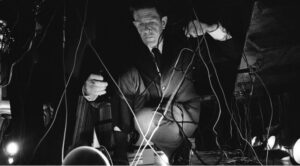by Diana Burgwyn
Osvaldo Golijov’s remarkable sound world in the opera Fountain of Tears (Ainadamar) is an amalgamation of his own Argentinian/ Jewish heritage and numerous other cultures, including Muslim, Jewish and Christian musical traditions. Above all, the score is suffused with the music of Lorca’s Spain: lush, seductive and with a strong undercurrent of sadness.

This dizzying array of folk music, meshed with western classical influences and jazz, has been transformed by the composer into a sophisticated musical language of his own. Even his orchestration is unusual, with guitars, marimbas and various kinds of Spanish percussion instruments added to the symphonic ensemble. Despite this unlikely combination of musical materials, the opera evolves organically, with one mode of musical expression seamlessly flowing into another and the present morphing into the past through flashbacks.
The short prelude is a vivid example of another Golijov characteristic: the use of non-musical sounds. It opens with pre-recorded drops of water falling into Ainadamar, the Moorish word for “fountain of tears,” while distant trumpets express what the composer calls “wounded freedom”—freedom desperately sought and denied. This is followed by the hoofbeats of galloping horses, which morph into a flamenco heel dance.
The first music we hear is a ballad sung by a group of young girls who function rather like a Greek chorus, commenting on events and predicting the future. Recalling the death of the 19th century political martyr Mariana Pineda, they tell of sadness so great that “the stones began to cry.” That ballad acts as a frame to the opera, recurring over and over until the very end.

The leading character in Ainadamar is the renowned actress Margarita Xirgu, whose grief at Lorca’s death and guilt over not having been able to save him has taken over her life. Golijov has captured these emotions brilliantly in his searing vocal lines. Margarita’s outpourings, often in a high soprano register, are full of tears—tears wept openly and those lodged in her heart. Only at the end of the opera, as she dies, does she move from bitterness to grace and acceptance.

The role of the charismatic poet/ playwright Lorca was not in the original score of the opera; Golijov added it during a revision. It was written for a mezzo-soprano rather than a male singer, reflecting Lorca’s androgynous voice and feminine sensibilities. (In real life, both Lorca and Xirgu were gay.) This role contains some of the composer’s most beautiful music, notably the dark and wistful “Aria of the Statue,” in which
he reflects on his childhood love of the statue depicting the martyred Mariana Pineda—a statue that for him was not cold and grey but warm and loving.
One more key character (a fictional one) for soprano appears in Ainadamar; that is Nuria, Margarita’s gifted student who, over the course of the opera, grows both musically and dramatically, recognizing
that it she who must carry on Lorca’s and Margarita’s message to the world.
The three roles for female voice achieve their greatest beauty late in the opera when the dying Margarita, Lorca (who has died), and Nuria intertwine their voices in a sensuous trio that is often compared with the trio in Richard Strauss’s Der Rosenkavalier.

One of Golijov’s most effective theatrical touches is the insertion of chilling, even ugly sounds. The role of the man who arrested and murdered Lorca, Ramon Ruiz Alonso, a fascist functionary in Francesco Franco’s authoritarian regime, is cast for a male flamenco singer, whose wailing cries condemn Lorca and his fight for freedom. Similarly, warlike messages broadcast by Radio Falange (the Spanish fascist party) vow to “exterminate the seeds of the Revolution.”
On the night before Lorca is murdered, hypnotic voices of the dead and soon-to-be dead surround him, praying to the Virgin of Guadalupe. The bullet that kills him becomes a rhythmic fugue of gunshots, with one becoming thousands, reflecting the huge number of killings that took place during the Spanish Civil War. Over those staccato volleys is heard a heartbreaking lament.
There is no comic relief in this tragic opera, but there are lighter scenes, one a raucous conversation between Margarita and Lorca that takes place in a bar, another when Margarita and Lorca sing a duet in the form of a Cuban rumba as they dream of taking refuge in Havana.
Osavaldo Golijov knows how to fill our hearts with beauty, pain, and terror, and even occasionally to make us smile. He is a musical magician. From the first bars of Ainadamar to the last, he puts us under his spell and does not let go.

Diana Burgwyn is a Philadelphia-based writer and music critic.






